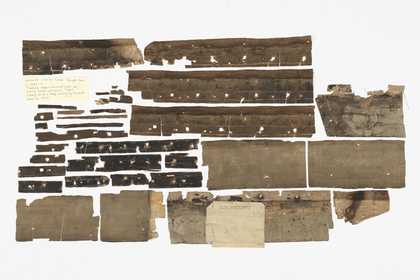Presenting the unseen parts of Turner’s paintings as artworks, Cornelia Parker questions the status we give objects
On a research visit to the Tate conservation department, Parker found a drawer ‘full of grimy pieces of canvas’. These were the liners and tacking edges of paintings by JMW Turner, which conservators had replaced in the 1960s. A liner is a layer of canvas placed over a stretcher before attaching the canvas on which the artist paints. This is done to protect the back of the painted canvas and to help keep it flat. A tacking edge is the part of the canvas which has been folded around the back of the stretcher.
Unlike the paintings themselves, this support material was never part of the national collection of British art, held by Tate. Parker gave each canvas the title of the Turner work from which it had been removed. Tate acquired them as contemporary artworks authored by Parker, so they are now part of the collection.
As well as marks left by the original support, some canvases show water stains from a flood in the Tate Gallery store after the Thames burst its banks in 1928. Parker says, ‘Turner was a master of capturing the intangible in paint, increasingly pushing his subjects to the point of abstraction. Somehow, this piece carries on that process.’
To see more of Cornelia Parker’s work, visit her exhibition in our Upper Galleries from 19 May–16 October 2022. Other works are displayed downstairs in the Manton foyer and in the Tate Britain collection displays alongside historical works they reference.

